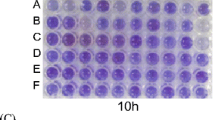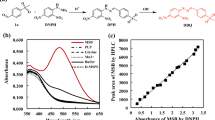Abstract
Atrazine chlorohydrolase (AtzA, EC 3.8.1.8) has attracted widespread interests as it catalyzes conversion of toxic atrazine to nontoxic hydroxyatrazine and can be used in the biodegradation of atrazine. To facilitate this application, a Haematococcus pluvialis-based method was applied to screen AtzA variants from a random mutagenesis library. Eight variants with enhanced enzyme activity were obtained. They showed 2.7- to 5.0-fold increase in specific activity compared with the wild type. Sequencing revealed that the two most active variants contained single substitution at Val12 and Leu395, respectively, while several improved variants contained substitutions at the four sites of Met315, His399, Asn429, and Val466 simultaneously, indicating that these residues contribute to the enzyme activity of AtzA. Kinetic analysis showed that five variants decreased the K m value 0.6- to 0.9-fold, whereas all the variants increased the catalytic efficiency (k cat/K m value) 2.5- to 4.1-fold compared to the wild type. The modeled three-dimensional structure showed that AtzA is comprised of a typical (β/α)8 domain of the amidohydrolase superfamily and a dual β-sheet domain. An iron ion and five ligand-binding residues are located in the β-barrel core of the (β/α)8 domain. Some substituted residues are involved in hydrogen bond formation in the (β/α)8-neighboring β-sheet.
Similar content being viewed by others
Abbreviations
- AtzA:
-
atrazine chlorohydrolase
- BBM:
-
Bold’s basal medium
- EP-PCR:
-
error-prone PCR
References
Gavrilescu, M. (2005) Eng. Life Sci., 5, 497–526.
Van der Meer, J. R. (2006) Front. Ecol. Environ., 4, 35–42.
Rhine, E. D., Fuhrmann, J. J., and Radosevich, M. (2003) Microb. Ecol., 46, 145–160.
Erickson, L. E., Lee, K., and Sumner, D. D. (1989) Crit. Rev. Environ. Control, 19, 1–14.
Macias-Flores, A., Tafoya-Garnica, A., Ruiz-Ordaz, N., Salmeron-Alcocer, A., Juarez-Ramirez, C., Ahuatzi-Chacon, D., Mondragon-Parada, M. E., and Galindez-Mayer, J. (2009) World J. Microbiol. Biotechnol., 25, 2195–2204.
Zhang, Y., Jiang, Z., Cao, B., Hu, M., Wang, Z., and Dong, X. (2011) Int. Biodeter. Biodegr., 65, 1140–1141.
De Souza, M. L., Wackett, L. P., Boundy-Mills, K. L., Mandelbaum, R. T., and Sadowsky, M. J. (1995) Appl. Environ. Microbiol., 61, 3373–3378.
De Souza, M. L., Sadowsky, M. J., and Wackett, L. P. (1996) J. Bacteriol., 178, 4894–4900.
Seffernick, J. L., McTavish, H., Osborne, J. P., de Souza, M. L., Sadowsky, M. J., and Wackett, L. P. (2002) Biochemistry, 41, 14430–14437.
Seibert, C. M., and Raushel, F. M. (2005) Biochemistry, 44, 6383–6391.
Rousseaux, S., Hartmann, A., Lagacherie, B., Piutti, S., Andreux, F., and Soulas, G. (2003) Chemosphere, 51, 569–576.
Strong, L. C., McTavish, H., Sadowsky, M. J., and Wackett, L. P. (2000) Environ. Microbiol., 2, 91–98.
Wang, L., Samac, D. A., Shapir, N., Wackett, L. P., Vance, C. P., Olszewski, N. E., and Sadowsky, M. J. (2005) Plant Biotechnol. J., 3, 475–486.
Wang, H., Chen, X., Xing, X., Hao, X., and Chen, D. (2010) Plant Cell Rep., 29, 1391–1399.
Chen, K., and Arnold, F. H. (1993) Proc. Natl. Acad. Sci. USA, 90, 5618–5622.
Turner, N. J. (2009) Nat. Chem. Biol., 5, 567–573.
Scott, C., Jackson, C. J., Coppin, C. W., Mourant, R. G., Hilton, M. E., Sutherland, T. D., Russell, R. J., and Oakeshott, J. G. (2009) Appl. Environ. Microbiol., 75, 2184–2191.
Raillard, S., Krebber, A., Chen, Y., Ness, J. E., Bermudez, E., Trinidad, R., Fullem, R., Davis, C., Welch, M., Seffernick, J., Wackett, L. P., Stemmer, W. P. C., and Minshull, J. (2001) Chem. Biol., 8, 891–898.
Seffernick, J. L., and Wackett, L. P. (2001) Biochemistry, 40, 12747–12753.
Bischoff, H. W., and Bold, H. C. (1963) Phycological Studies IV, The University of Texas publication (6318), Austin, pp. 1–95.
Jones, A., Lamsa, M., Frandsen, T. P., Spendler, T., Harris, P., Sloma, A., Xu, F., Nielsen, J. B., and Cherry, J. R. (2008) J. Biotechnol., 134, 325–333.
Stemmer, W. P. (1994) Nature, 370, 389–391.
Brown, L. E., Sprecher, S. L., and Keller, L. R. (1991) Mol. Cell. Biol., 11, 2328–2332.
Bradford, M. M. (1976) Anal. Biochem., 72, 248–254.
Kelley, L. A., and Sternberg, M. J. E. (2009) Nat. Protoc., 4, 363–371.
Wass, M. N., Kelley, L. A., and Sternberg, M. J. E. (2010) Nucleic Acids Res., 38, W469–W473.
Hernandez, M., Villalobos, P., Morgante, V., Gonzalez, M., Reiff, C., Moore, E., and Seeger, M. (2008) FEMS Microbiol. Lett., 286, 184–190.
Liu, X., and Parales, R. E. (2009) Appl. Environ. Microbiol., 75, 5481–5488.
Yang, Z., Zhang, L., Zhang, Y., Zhang, T., Feng, Y., Lu, X., Lan, W., Wang, J., Wu, H., Cao, C., and Wang, X. (2011) PLoS One, 6, e22981.
Burgess, R. R. (2009) Methods Enzymol., 463, 259–282.
Chen, D., Chen, X., and Cai, B. (2004) Acta Scientiarum Naturalium Universitatis Nankaiensis, 37, 109–114 [in Chinese].
Bordoli, L., Kiefer, F., Arnold, K., Benkert, P., Battey, J., and Schwede, T. (2009) Nat. Protoc., 4, 1–13.
Ortiz, A. R., Strauss, C. E. M., and Olmea, O. (2002) Protein Sci., 11, 2606–2621.
Guo, H. H., Choe, J., and Loeb, L. A. (2004) Proc. Natl. Acad. Sci. USA, 101, 9205–9210.
Baker, D. (2000) Nature, 405, 39–42.
Author information
Authors and Affiliations
Corresponding authors
Additional information
Published in Russian in Biokhimiya, 2013, Vol. 78, No. 10, pp. 1412–1421.
Originally published in Biochemistry (Moscow) On-Line Papers in Press, as Manuscript BM13-062, August 18, 2013.
Electronic supplementary material
Rights and permissions
About this article
Cite this article
Wang, Y., Li, X., Chen, X. et al. Directed evolution and characterization of atrazine chlorohydrolase variants with enhanced activity. Biochemistry Moscow 78, 1104–1111 (2013). https://doi.org/10.1134/S0006297913100040
Received:
Revised:
Published:
Issue Date:
DOI: https://doi.org/10.1134/S0006297913100040




